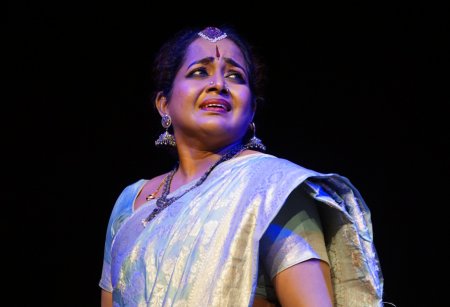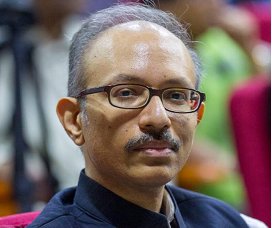
|   |

|   |
The ten stages of desire - Love and longing in an ancient text - GV Anna Rao e-mail: gvannarao@gmail.com Photos: GV Anna Rao December 12, 2023 SICA organised an evening ballet at Ravindra Bharathi on the 8th of November to conclude their annual festival. Many ancient treatises speak about (Nayikas) heroines and their moods in classical Sanskrit literature. One such little known work is the 'Rasavarna Sudhakaram' of the Telangana ruler Sarva Singha Bhupala. The Recherla family who were hereditary commanders of the Kakatiya army established after the fall of that dynasty the independent kingdoms of Rachakonda and Devarakonda. During the time of this ruler in the 14th century, a polished court of poets and scholars took shape in a minor cultural renaissance. The erudite king composed a work which contains a systematic classification of Dasa Kama Avasthas i.e., Ten Stages of Love. The heroines portrayed here were the subject of a series of solo Kuchipudi predominantly abhinaya based items. These were aptly selected by Dr. Yashoda Thakore to illustrate the lovelorn predicaments which the book describes. The draped styling of the costumes was effectively given an antique look to match. The beautiful friezes of dance sculptures of the Ramappa temple columns in Warangal were thus evoked. To fit in the pieces matching the ten moods was a task of commendable effort as they precisely brought out the subtle nuances of expression which were able to dissect and analyse in microscopic detail the emotions of love as perceived by the author. The live orchestra harmonised well to give a rich and vibrant aura to the packed hall. The evening began with Aapeksha and her colleagues presenting a brief nritta piece, followed by an explanation in English which set the tone for the recital. This set of dancers introduced the salient features of the items which followed in a highly interesting manner of question and response - a feature which continued throughout the presentation.  Sampreeti Sampreeti, in saffron gold dress lit up the stage with a soft glow as she depicted Desire, Reminiscence and Anxiety. She voiced her complaint about the injustice of being subjected to undeserved blame and upbraided the culprit sternly protesting her innocence. For a smile she gave the Lord she had to endure rebukes and infamy. This was the first composition of 'Abhilasha' stage. Annamacharya padam showed Alamelu Manga as she waits for Lord Venkateswara and thinks it is like eternity to recall his presence in absence, 'Aanusmriti'. Sampreeti realistically sighed and gazed with an introspective look. 'Udvega' was the lyrical "Sakhi Prana" where her face in mukhabhinaya glowed with anger as she voiced to her friend what her lover has done by deserting her for another lady. He is also guilty of rejecting her advances.  Sindhuja Sindhuja chose Contemplation, Praise and Lamentation - Chinta, Gunakirtanam and Vilapam. Her faceted abhinaya sparkled in iridescent green aharya making her seem like a glittering emerald. In "Toyajakshi," a winsome heroine traipsing about the stage with a wandering look enacted perfectly by the artiste, wants her Lord to be fetched as soon as possible without delay as she is interested in nothing else but her Narayana without whom she is lost. "Cheli Nenetlu" is a vigorous piece with brisk rhythm where the Nayika says, "I can't tolerate!" as a refrain, while describing her beloved's handsome majesty for whom her flower bedecked beauty is destined. Sindhuja struck a commanding pose as Chamendra the king with superb poise. A life without the lover is an unbearable burden is the subject of "Chalu Chalu." Loneliness is the theme with all the enchantment of lovely nature being insufficient to fill the gap. All worldly pleasures become tasteless when he is not there to share.  Yashoda Thakore Madness- 'unmadam' - was portrayed by Yashoda in "Marulu Minchenura" wearing a pastel blue costume as the outpouring of an almost insane love arising from the Nayika being unable to distinguish the presence or absence of her Lord. An unstable mind was suitably depicted in halting steps and faltering gait with bewildered looks in seasoned abhinaya which captivated the audience. Illness, Apathy and Death - Vyadhi, Jadatha and Marana were encapsulated in the melodious ashtapadi "Savirahe." Radha's tragic scene passes through all these stages of moods entrancingly evoked by Yashoda in a deeply sorrowful manner rendering the heartbroken visage of the heroine. The shades of emotions seamlessly melded as they changed tone while describing fragrant sandalwood and pleasant moon being cursed as Radha suffers the pangs of separation. Her charming face has lost lustre and she implores the presence of Krishna's shelter. Her tearful eyes resemble water bearing clouds. Applause was prolonged at the program's conclusion.  G.V. Anna Rao (Convenor, Natya Swara) has been arranging classical dance programs and festivals for more than a decade in Hyderabad. He has also been reviewing dance performances for the Hans India Newspaper for many years. Having a keen interest in photography, many of the pictures taken by him have appeared in the Hindu's Friday Review occasionally. He is also a member of INTACH. |